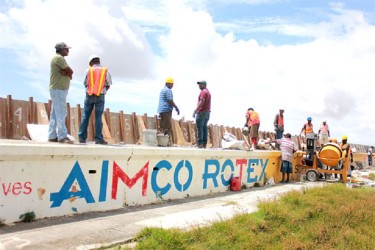The experimental heightening of the seawall along the Rupert Craig Highway is in full swing in the aftermath of stunning overtopping by Atlantic waves in April.
A large crew from the Public Works Ministry was along the highway on Saturday erecting a new section. The first section was erected at Ogle while the new installation can be seen along the Bel Air section of the highway.
Public Works Minister Robeson Benn had previously told Stabroek News that additional sea defence experimental works would be tested in the upcoming months. He had said that the ministry was looking at a seawall extension, however a design was needed that wouldn’t cause trauma to the current structure but could still hold up against the strong tides. The new construction appears to be a concrete fixture attached to the wall adding approximately 2.5 feet of height and has surpassed over 100 feet in length. The base of the addition is porous with channels to possibly break the impact of the waves and prevent the new construction from being torn down when tides are strong.

When Stabroek News inquired as to the dimensions of the seawall extension and where along the seawall the Public Works Ministry was looking to erect additions, Geoffrey Vaughn, Coordinator of the Ministry’s Works Services Group, said that the construction was just experimental for the time being. He did not further elaborate on the new device, but did note that assessing how helpful it was in flood prevention would help in finding more permanent solutions.
The highway is still lined with sandbags from Kitty to Bel Air in anticipation of ongoing high tides and potential overtopping. The Public Works Ministry had said previously that the sandbagging was temporary but the best solution for the time being, keeping costs relatively low while other sea defence projects were worked on.
Since the end of May, the Public Works Ministry has been working on various engineering solutions with multiple experiments being proposed. The ministry had promised that a report on their findings would be finished by the end of June and that the minister would pronounce on the way forward in the development of more permanent solutions.
The European Union committed to investing up to $4 billion over the next three years to help with sea and river defences in May after Guyana dealt with record- breaking waves which caused overtopping on a large scale along the Rupert Craig Highway and other areas. The EU delegation in Guyana also had a technical expert assess the current state of the coastal structures from the consultancy with Engineering, Environmental Science and Economics. A final report is expected in the near future from both the ministry and the EU Delegation.




